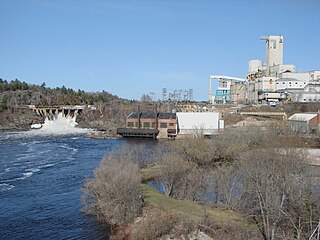
Espanola is a town in Northern Ontario, Canada, in the Sudbury District. It is situated on the Spanish River, approximately 70 kilometres west of downtown Sudbury, and just south of the junction of Highway 6 and Highway 17. The town is where the first experimental rules for the sport of ringette were created in 1963 by Mirl Arthur "Red" McCarthy using a group of local high school girls. Today Espanola is considered "The Home of Ringette" while North Bay, Ontario is considered the "Birthplace of Ringette" though the title of "birthplace of ringette" is often shared by both.

Vale Canada Limited is a wholly owned subsidiary of the Brazilian mining company Vale. Vale's nickel mining and metals division is headquartered in Toronto, Ontario, Canada. It produces nickel, copper, cobalt, platinum, rhodium, ruthenium, iridium, gold, and silver. Prior to being purchased by CVRD in 2006, Inco was the world's second largest producer of nickel, and the third largest mining company outside South Africa and Russia of platinum group metals. It was also a charter member of the 30-stock Dow Jones Industrial Average formed on October 1, 1928.

The Michipicoten River is a river in Algoma District of northern Ontario, Canada, which flows from Dog Lake and joins with the Magpie River to empty into Michipicoten Bay on Lake Superior near the town of Wawa. This river is 113 km (70 mi) in length and drains an area of about 5,200 km2 (2,000 sq mi).

Walden was a town in the Canadian province of Ontario, which existed from 1973 to 2000. Created as part of the Regional Municipality of Sudbury when regional government was introduced, the town was dissolved when the city of Greater Sudbury was incorporated on January 1, 2001. The name Walden continues to be informally used to designate the area.

Nickel Centre was a town in Ontario, Canada, which existed from 1973 to 2000.
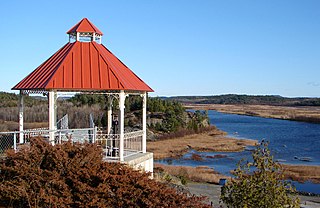
The Spanish River is a river in Algoma District, Sudbury District and Greater Sudbury in Northeastern Ontario, Canada. It flows 338 kilometres (210 mi) in a southerly direction from its headwaters at Spanish Lake and Duke Lake to its mouth at the North Channel of Lake Huron just outside the community of Spanish.

The Mississagi River is a river in Algoma and Sudbury Districts, Ontario, Canada, that originates in Sudbury District and flows 266 kilometres (165 mi) to Lake Huron at Blind River, Algoma District.

Vale S.A., formerly Companhia Vale do Rio Doce is a Brazilian multinational corporation engaged in metals and mining and one of the largest logistics operators in Brazil. Vale, is the largest producer of iron ore and nickel in the world. It also produces manganese, ferroalloys, copper, bauxite, potash, kaolin, and cobalt, currently operating nine hydroelectricity plants, and a large network of railroads, ships, and ports used to transport its products.
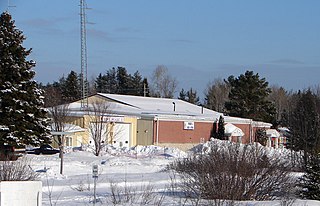
Nairn and Hyman is a township in the Canadian province of Ontario. The township, located in the Sudbury District, borders on the southwestern city limits of Greater Sudbury west of the city's Walden district. The township had a population of 342 in the Canada 2016 Census.

The Huron Central Railway is a railway operating in northern Ontario, Canada. It is operated by Genesee & Wyoming Canada, the Canadian subsidiary of Genesee & Wyoming.
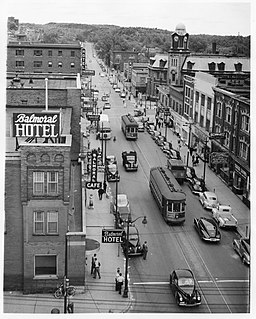
The Sudbury and Copper Cliff Suburban Electric Railway was a privately-owned electric interurban railway and streetcar system that connected several neighbourhoods in the town of Sudbury, along with what was then the town of Copper Cliff in Ontario, Canada. Incorporated in 1912, the company began revenue passenger service in November 1915. It ultimately grew into a system of three radial lines which joined together in downtown Sudbury. By the late 1940s, however, rail service was being supplemented with diesel buses. Rail service ended in October 1950 and was completely replaced with bus service, which over time evolved into municipal Sudbury Transit and later GOVA services.

Ear Falls is a township located in Northwestern Ontario, Canada, on the banks of the English River, Lac Seul, Pakwash Lake and Wenesaga Lake. It is located along Highway 105, 100 kilometres (62 mi) north of Highway 17 and Vermilion Bay, about halfway between Highway 17 and Red Lake, or about 480 kilometres (300 mi) northwest of Thunder Bay.
Agnew Lake is a lake on the Spanish River in the Sudbury District, Ontario, Canada. Its area is 2,940 hectares and its shoreline is 210 kilometres (130 mi) long.
The Vermilion River is a river in the Lake Huron drainage basin in Sudbury District and Greater Sudbury in Northeastern Ontario, Canada.
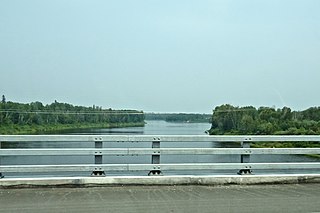
The Groundhog River is a river in Cochrane District and Sudbury District in Northeastern Ontario, Canada. The river is in the James Bay drainage basin and is a left tributary of the Mattagami River.
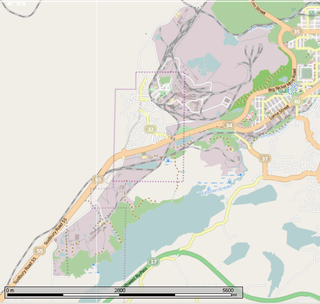
The Vale Railway, formerly the INCO Railway, is an industrial railway operating in the City of Greater Sudbury, Ontario, Canada. It is owned and operated by Vale Limited.
The Algoma Eastern Railway was a railway in Northeastern Ontario, Canada. Originally known as the Manitoulin and North Shore Railway (M&NS) with a charter dating back to 1888, the full mainline was opened to traffic in 1913, serving the area along the north shore of Lake Huron between Sudbury and Little Current on Manitoulin Island. It and its sister railway, the Algoma Central, were originally owned by the Lake Superior Corporation, a conglomerate centred on Sault Ste. Marie which was founded by the American industrialist Francis Clergue. Despite ambitious plans to expand across Lake Huron to the Bruce Peninsula using a railcar ferry, the company failed to develop further and was acquired by the Canadian Pacific Railway in 1930. With freight traffic low during the Great Depression, Canadian Pacific soon abandoned much of the Algoma Eastern mainline in favour of its own Algoma Branch. Remaining sections of the Algoma Eastern line were turned into spurs, with the longest surviving section operated as a branch line known as the Little Current Subdivision.
O'Donnell is a ghost town and former industrial area inside the city of Greater Sudbury, Ontario, Canada, which today is located on property owned by Vale Limited. It was located along the Algoma Eastern Railway line between two mine sites, Crean Hill and Gertrude. It functioned as a brief offshoot of the nearest major settlement along the line, the Inco company town of Copper Cliff, which today is a suburb of Sudbury.

The Anderson Farm Museum is a local history museum, heritage centre, and event space in Lively, Greater Sudbury, Ontario, Canada. It is located on the site of the former Anderson family farm, a 14-acre (57,000 m2), mostly-outdoor site containing the original farm buildings, artifacts from local history, as well as a heritage building from the former community of Creighton.
The Wabagishik Dam and Generating Station is a concrete gravity dam and hydroelectric power plant on the Vermilion River. It is located within the former town of Walden in Greater Sudbury, Ontario, Canada. The complex is owned and operated by Vale Limited, which is notable in the area for its mining operations.















